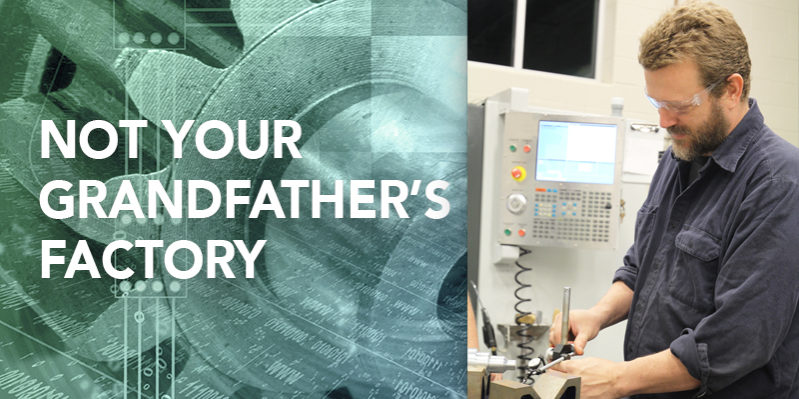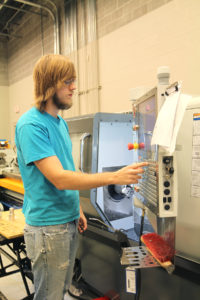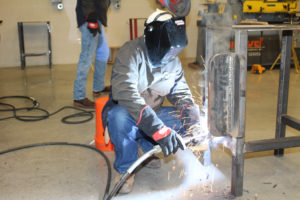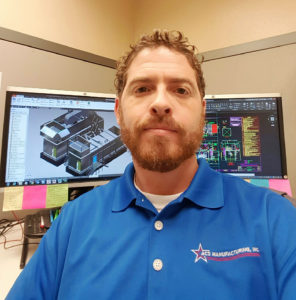
Next generation industrial careers need high-tech skills
What do you think of when you imagine a shift change at a factory? Unless you work inside one, chances are you think of a whistle, punch-cards and time-clocks, and thousands of workers pouring out of the gates.
The assembly line of Henry Ford’s day still shapes public perception of manufacturing. But within the industry, vast changes in technology and global trade have transformed the way we design and produce things.
We live in the era of Advanced Manufacturing, where workers with a high level of technical skills are needed to run and maintain complex machines, robots, and computer systems. Far from the negative stereotypes of manufacturing, many of the new jobs in the industry are clean, steady, and offer good pay.
 In fact, factory workers are some of the best paid workers in the country, says AJ Jorgenson of the Washington policy think-tank the Manufacturing Institute. “Today’s manufacturing employees earn higher wages and receive more generous benefits than other working Americans.” For 2015, the mean average for a Texas Computer-Controlled Machine Tool Operator was $18.78 an hour, while for Texas Machine Setters, the mean was $19.41, compared to $18.07 nationally. Industrial Machinery Mechanics make a great wage in the state of Texas- $25.05 an hour.
In fact, factory workers are some of the best paid workers in the country, says AJ Jorgenson of the Washington policy think-tank the Manufacturing Institute. “Today’s manufacturing employees earn higher wages and receive more generous benefits than other working Americans.” For 2015, the mean average for a Texas Computer-Controlled Machine Tool Operator was $18.78 an hour, while for Texas Machine Setters, the mean was $19.41, compared to $18.07 nationally. Industrial Machinery Mechanics make a great wage in the state of Texas- $25.05 an hour.
Demand for skilled labor is skyrocketing. According to Economic Modeling Specialists International (EMSI) projects, “There are over 300,000 new jobs in advanced manufacturing since 2011 (6% growth), which accounts for nearly half of all new manufacturing jobs (618,000 new jobs since 2011, growing at roughly 5%).”
“Some of our students find jobs while they’re still taking classes,” says Kenny Smith, NCTC Industrial Technology Dept. Chair. Equipped with more than four decades of advanced manufacturing experience, Smith leads the Industrial Technology program at NCTC.
Out with the old, in with the new
As the Baby Boom generation retires, demand for new manufacturing workers will only continue to grow. Currently, Baby Boomers make up about 20 percent of the overall workforce, and an even larger share of industrial jobs. “A lot of businesses are seeing older guys with CNC and other advanced manufacturing experience retiring out,” notes Smith, “and they don’t have individuals to replace them.” As it turns out, 23 of the 35 advanced manufacturing industries have experienced national job growth since 2011.
 However, public perception remains a struggle, says Rob Sentz, Chief Innovation Officer at EMSI. Following the massive layoffs in the automobile industry, he says he’s seen parents advising their children against pursuing a career in manufacturing. “Parents still think it’s dirty, dark and dangerous,” Gugger says. “It’s nothing like it used to be. Manufacturing medical devices is lab-coat work.”
However, public perception remains a struggle, says Rob Sentz, Chief Innovation Officer at EMSI. Following the massive layoffs in the automobile industry, he says he’s seen parents advising their children against pursuing a career in manufacturing. “Parents still think it’s dirty, dark and dangerous,” Gugger says. “It’s nothing like it used to be. Manufacturing medical devices is lab-coat work.”
This has contributed to what employers call a ‘skills gap,’ with too few technical workers filling too many jobs. “Eighty percent of manufacturers report they cannot find individuals with the skills required,” the Manufacturing Institute’s Jorgenson notes. “I see this as a huge opportunity for anyone going into this line of work. The wages are good,” says Smith.
While the Labor Department reports that manufacturing jobs have declined 35 percent since 1980, the industry has seen a steady resurgence in recent years as companies move operations back to the US – a trend called “reshoring,” or “insourcing.”
“Where the thought becomes the thing”
American manufacturing is leaner, and far more productive, than the factories of old. In fact, the Manufacturing Institute reports that in the two decades up to 2012, manufacturing output increased more than 83 percent.
Against an economic backdrop of the “rise of China,” it’s easy to forget that the US continues to be far and away the largest overall producer of goods and services in the world. If the US manufacturing sector were its own country all on it’s own, it would still rank as the eighth largest economy in the world – producing more than the entire gross domestic product of India, a well-known export giant!
Manufacturing in America is leaner, but smarter today. This means that the jobs that “return” to the US are different than those that left in the past several decades. They are more technical, and 80 percent require some training, according to a 2012 study by Georgetown University’s Public Policy Institute.
“Today’s manufacturing is about advanced technologies, state-of-the-art facilities, and fast-paced work environments,” states Jorgenson. “It’s where the thought becomes the thing.”
In other words, manufacturing capability has reached the point of “If you can dream it, you can build it.”
In-demand skills
The Labor Department’s annual Occupational Outlook Handbook describes some of the most sought-after occupations.
Welders
Welders permanently bind metal pieces together using heat application. Because of how strong the bond is, this technique is used in fields of large manufacturing, such as automotive and shipbuiding. This means that welders can work in a wide array of different jobs, using different techniques depending on the field. Arc welding is the most common kind of welding, but there are more than 100 different processes that a welder can use. Cutting, soldering and brazing are all very similar manufacturing careers that are closely related to welding.
The median pay for welders in Texas in 2015 was $18.84 hourly, or $43,580 per year. Texas has the highest employment rate for this industry over all other states. In 2015, there were 55,020 jobs in welding in Texas alone. And although the projected job growth is only 4%, welders with an education, experience or certificate should have much less difficulty finding a job than those just starting in the field.
Computer Aided Design (CAD)
Computer-aided designers use computers to create technical drawings, help design products, and work with architects, machinists, and engineers to give precise dimensions and instructions for making things. They are often called CAD operators, because the work they do is frequently programmed directly into computer systems that render their designs in
three dimensions.
In 2015, CAD operators in Texas made a median pay of $26.94 per hour, or $56,035 per year. Employers generally prefer applicants who have completed an associate’s program. These workers can work in many fields, from aeronautical to civil drafting, working with architecture firms on construction projects, or with pipefitting operations at oil refineries. Most of a designer’s workday involves a computer, although some projects require visits to a job site.
Computer Numerical Control (CNC)Programmers
Computer Numerical Control (CNC) programmers develop programs that control machines on the factory floor. They automate production, making the manufacturing process faster, safer, more precise, and more efficient.
Those who excel in this line of work are good with computers and solving problems. The vast majority of CNC programmers, according to a federal survey of the field, hold associate’s degrees or post-secondary certificates.
CNC programmers earned median wages in 2015 in Texas of $26.74 an hour, or $55,619 per year. The Labor Department projects average job growth (6 percent) in this field through 2024.
Student Success Story: Heath Morrow
Engineering Technology
AAS Graduate

Heath Morrow
Like a lot of people, Heath Morrow struggled in school. As a result of these struggles and poor choices, he was not going to be able to graduate with his class. While he was able to obtain his GED® in April of his senior year of high school, he had no intention of continuing his education in college. He began working in manufacturing straight out of high school and later worked in construction.
Heath married in his early twenties, and over the years was blessed with three beautiful daughters. At the age of 30 he realized that he needed to return to school. He wanted a career, rather than a job. Heath applied to North Central Texas College, but was unsure of what career to pursue. He began to take core classes that were needed for a degree. While at a school event for one of his daughters, he began talking with a friend that is an NCTC graduate, and employed as a designer/drafter. Heath was interested, but expressed his concern because he had struggled in high school. His friend Mike encouraged him, telling him that he would be able to get through the courses.
Heath decided to give it a try and started taking the courses required for the Engineering Technology (Drafting) program at NCTC. He enjoyed his classes, as well as the instructors that he encountered. A year before he graduated, one of his instructors sent him a job opportunity at a local business. Heath applied and was offered the job at a higher rate of pay than he was currently making. He was also promised a substantial raise once he graduated. Heath was getting training not only through work, but in class as well. Once he graduated, the company was true to their promise, and Heath received a healthy raise. He has since gained more knowledge, giving him the opportunity to move up in a career he enjoys, and is able to comfortably provide for his family.
Have us contact you by filling our the form below or visit our website for more information about the program and NCTC as a whole.
